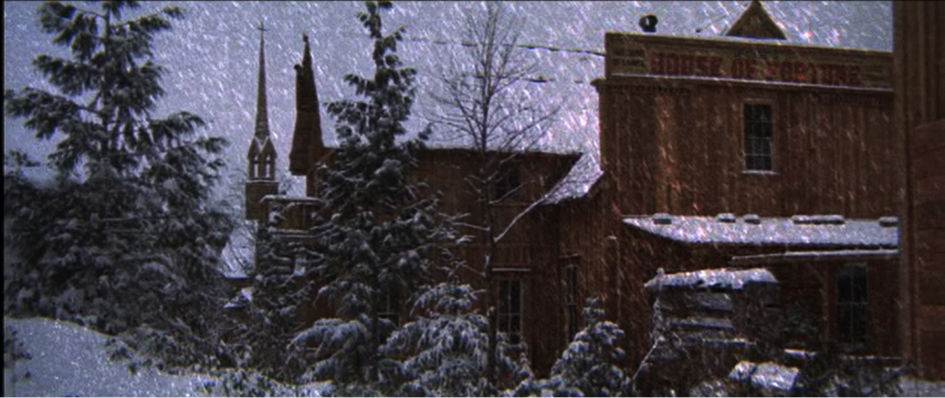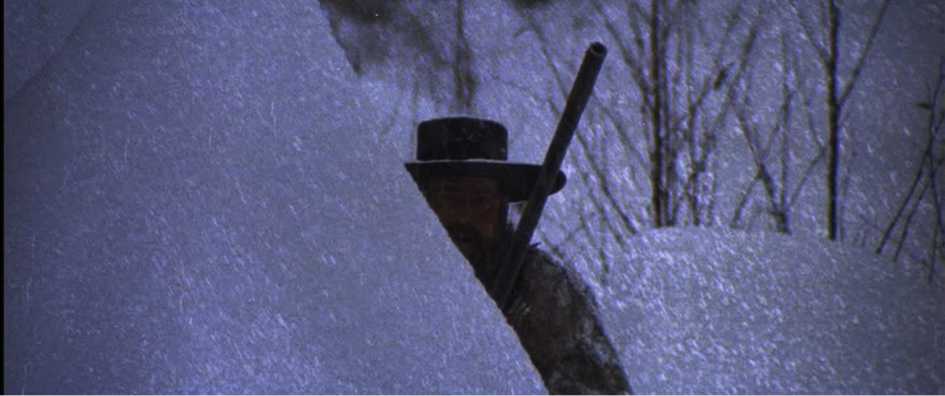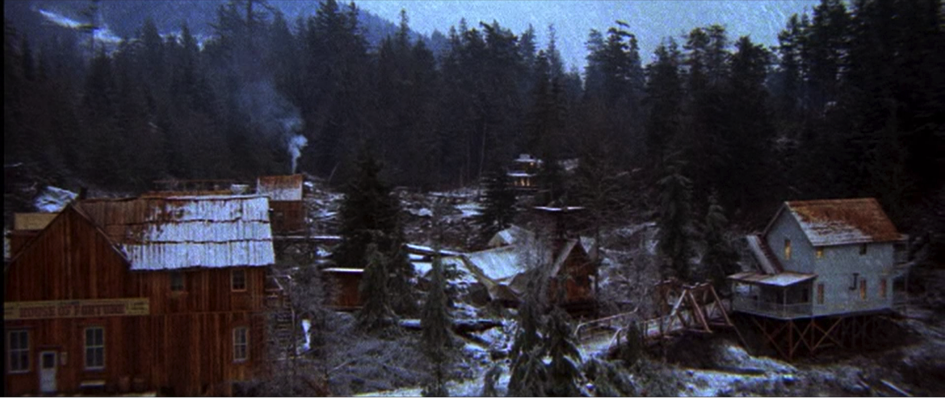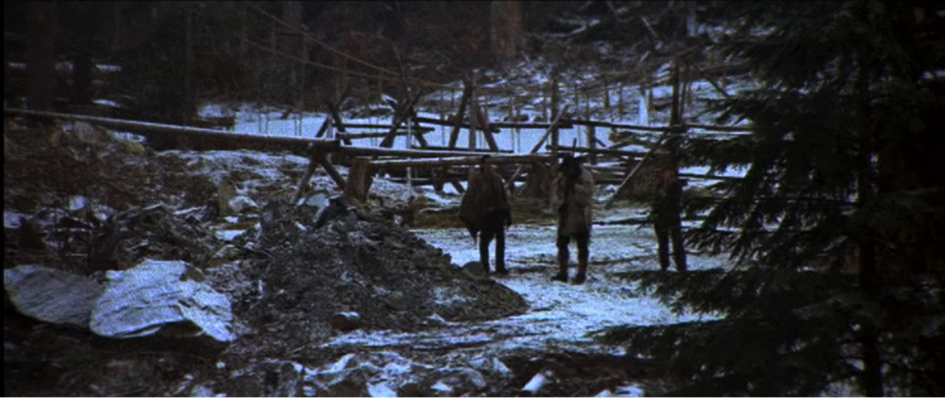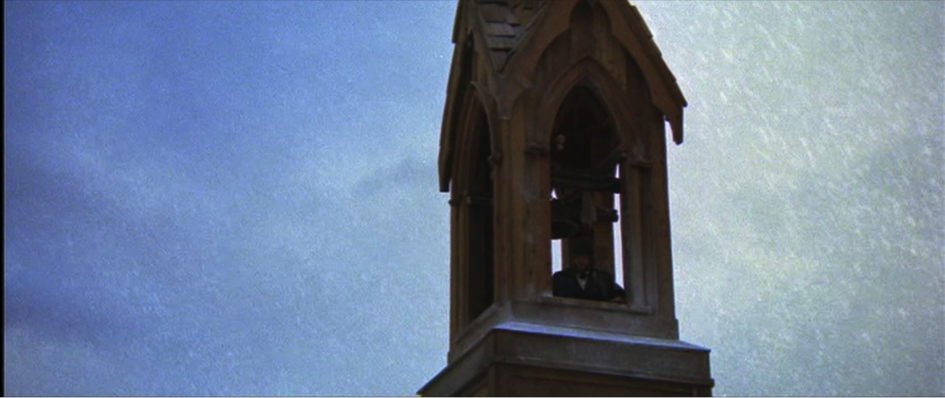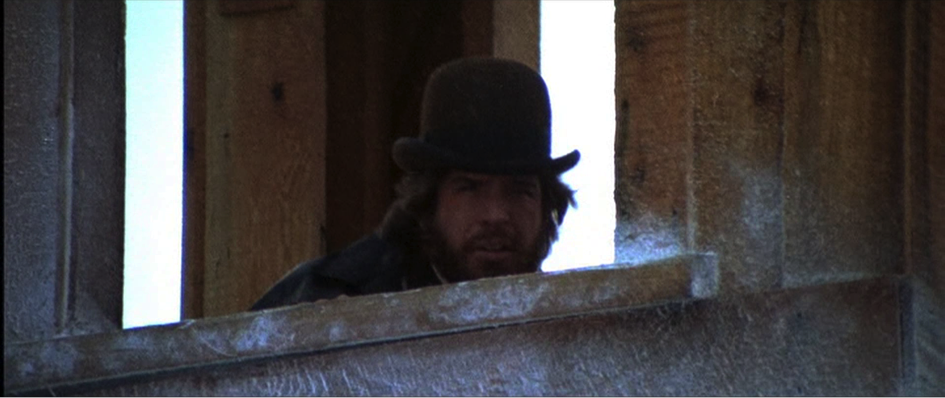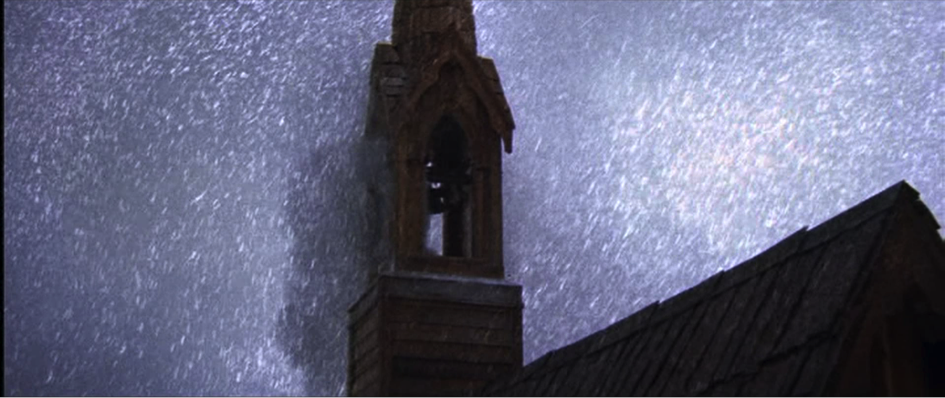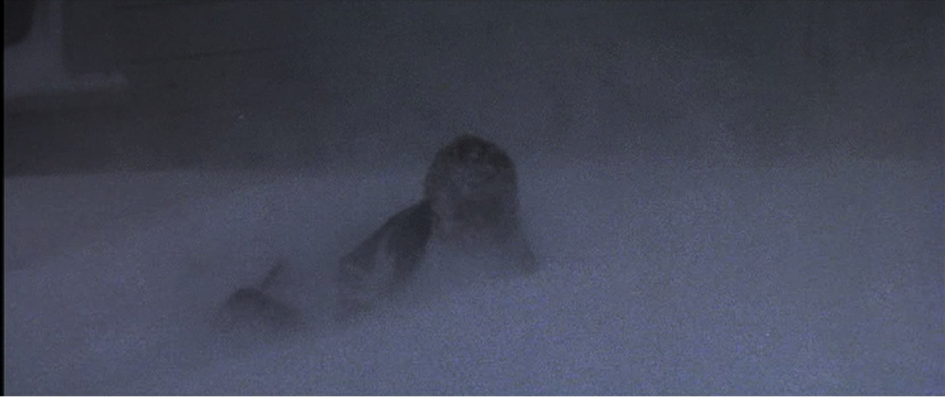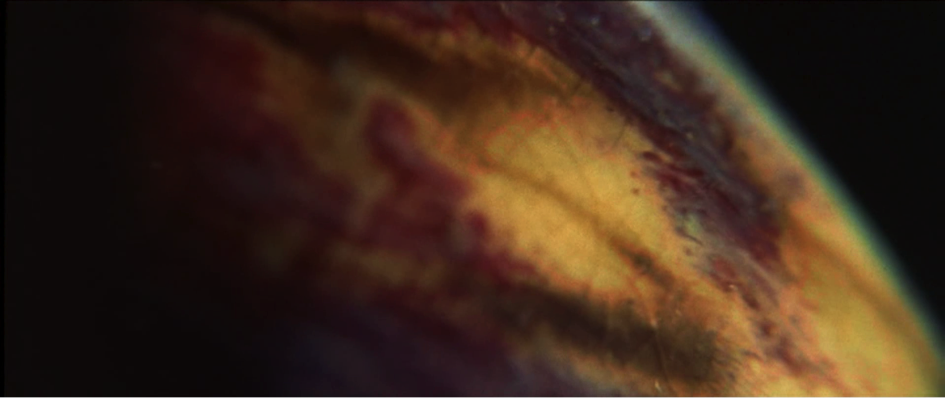Hauke Lehmann
How do films make their spectators feel? And how might a history of this relation look? The perceptual and affective relation between the filmic image and its spectator is often regarded as being based on universally shared bodily capacities and is, as such, believed to be historically stable – at least with respect to the relatively short time span of film history. In this essay I would like to suggest some arguments supporting the idea that, on the contrary, the history of film can be (re-)written as a history of feeling.
It is towards this end that my thoughts on filmic texture and, particularly, on becoming-texture, are organised. Hence, in my view, texture can never be dissociated from its historical circumstances; it is intertwined with them as the expression of a specific time and place (in this case, the cinema of the New Hollywood). But what is texture? Rudolf Arnheim defines it as a perceptual relation where the spectator’s orientation is dispersed "from the scrutiny of individual structural relationships […] to that of overall structural constants" (Arnheim 1957: 25). With regard to film we are dealing with a conceptual shift from movement in the narrow sense towards an audiovisual dynamic that exceeds clear localisation. Hence, texture is not concerned with a displacement from location A to location B, but with changes in intensity and material quality: from soothing to effervescent, from rough to soft, from wet to dry, from hectic swarming to stillness. In his definition of texture, Arnheim refers – as do many concepts of texture – to painting, in particular to an American tradition of painting in the vein of Jackson Pollock. It is worth quoting his analysis at some length:
Such a picture can be perceived only as texture – not because the number or size of the units of which it is made up go beyond the range of the human’s eye capacity but because the units do not fit into more comprehensive shapes. The number of elements is large enough so that their variations as to color, shape, size, direction, relative position, etc., compensate each other, and a common denominator of textural qualities such as prickliness, softness, excitation, viscosity, mechanical hardness or organic flexibility emerges from an inspection of the whole. All movements, also, are compensated so that nothing ʻhappens’, except for a kind of molecular milling everywhere. (1957: 26)
Although he is analyzing a painting, Arnheim remarkably describes not only one, but two kinds of movement – even if they are apparently not the kind of movement he expects (and prefers) to find in a painting. One is the emergence of ʻa common denominator of textural qualities’; the other is ʻa kind of molecular milling everywhere’. These two could also be regarded as two dimensions of the same movement: one refers to the overall perceptual relation between the viewer and the painting, the other refers to the specific kind of elemental activity that is going on (I will elaborate on the concept of elements further below). Both seem to merge in a dynamic of compensation, that is, in a kind of in-picture tension that is responsible for the de-focusing effect Arnheim describes in his definition of texture: there seems to be no way of localising a (suggested) movement leading from A to B, but rather a sort of animation that affects the way the picture is brought to life as a whole. This ultimately begs the question of how the subject and object of perception are situated with regard to each other.
Correspondingly, an analysis of filmic texture is not primarily looking at the actions of characters, or at the development of narrative. Rather, it concentrates on the way the world of the film itself is made visible and audible in the first place, and how this way changes over time: is the light getting brighter, as a given scene progresses? Are spaces being filled with objects, or drained from them? Is the fog lifting from the streets? And how do changes like these (far from constituting redundant, additional information with regard to the ʻreal’ action) affect and modulate the way spectators relate to a scene emotionally?
Over the course of the following essay, I would like to elaborate on the intuition, expressed above in a still oblique manner, that the concept of texture has to be linked in some way to the problem of temporality. In order to further elucidate what is meant by texture, and what could be meant by becoming-texture, an analytical demonstration will be helpful, on the basis of which I can develop my argument. Thus, I will closely analyse the function of texture in a paradigmatic example; namely, the final sequence of Robert Altman’s MCCABE & MRS. MILLER (US 1971). Building on this analysis, I will elaborate on how texture helps to establish a new relation between film and spectator. Finally, I am going to explain how this new relation is relevant for our understanding of New Hollywood cinema and, by extension, of film history.
MCCABE & MRS. MILLER
The advent of New Hollywood cinema in the late 1960s brings about a significant unfolding of nuances in nearly all registers of cinematic expression: camera movement, quality of sound, style of acting, rhythms of editing, tonalities of light and colour. These new nuances are often the result of deviations from the classical spectrum of expression, sometimes enabled by technical developments: the use of handheld camera, on-location shooting (with on-location sound), flashing (and thereby de-saturating) the film, use of dialects, emphasis on tics and other idiosyncrasies in acting, etc. Many of these changes are directly concerned with what can be called filmic texture. This can be demonstrated with a prominent example: MCCABE & MRS. MILLER is regarded as a canonical work of the New Hollywood (cf. Self 2007). Upon its release and during the following years there have developed two major strands of discussion in its regard (cf. Kolker 1988: 313ff). The first focuses on its supposedly revisionist stance towards the western genre (Schatz 1983: 249, Self 2007: 46ff), the second, often seemingly rather incidental to the first, emphasises the specifics of its markedly artful cinematography and its poetic implications (Burgess 1971, MacLean 1978). I propose reversing this order. For it is certainly first and foremost through the remarkable way the film stages the interplay between elemental forces (wind, rain, snow, mud, fire, ice and water, inside and outside, warm and cold, dry and wet) that a sense of temporality, or of historicity transpires as the spectator’s bodily experience. This experience is modulated, first and foremost, by the film’s utilisation of texture. The main task of analysis will therefore be to describe the specific relation between film and spectator that is opened up by texture. Only on the basis of such a description is it possible to assess the position the film occupies in relation to other films and in relation to genre and other aspects of film history. To quote an early review: "[…] rarely has the weather and the progress of the seasons been more meticulously attended to in a film without investing it with some symbolic or sentimental importance" (Burgess 1971: 51). The weather is indeed not a readymade symbol here; instead, it structures the spectator’s experience of the film as it unfolds over the concrete duration of its perception. It is from this temporal structure that a sense of historicity emerges. This sense of historicity pertains to the way that the passing of time affects our sense of being in the world, that is to say: our way of feeling. This idea can be glimpsed in another article on the matter:
MCCABE & MRS. MILLER […] may be thought of as a film about snow, documented in a range of phases which filter the action, as the thaw-fed river mediates the image of a cowboy hovering eerily beneath its surface; one of the chief characters is a man frozen into an image, a ʻrep’ that precedes and outlives him, just as his contours are swept smooth in the final snowstorm; and its plot concerns his struggle for control with that matriarchy which usually prevails in Altman’s films, and which here offers shelter from the frozen snowscape. (MacLean 1978: 2)
This essay is concerned with linking this description of the filmic image to the description of the plot. It argues that the affective relation of film and spectator is based on the filmic modulation of the experience of time and duration, structured, in this example, on the interplay of elemental forces. In the following analysis I would like to demonstrate how that interplay is realised as the composition of filmic textures unfolding over time, and how it acquires meaning in its being experienced by the spectator.
The Final Sequence: Snow
While elemental forces (especially in the form of weather conditions) ground the film’s world from its beginning (e.g., the first sequence is built from the fundamental contrast of the rainy outside with the dark and cramped inside, the contrast being realised in the movement of the protagonist), the extended final sequence reaches a new level of interweaving them with the three strands of dramatic action: McCabe’s fight against the gunmen, the townsfolk’s struggle against the church fire, and Mrs. Miller’s retreat into opium. For the first part, the prolonged shootout completely dominates the narrative structure. After a while, the fire segment emerges to then alternate with the shootout for a while. When both strands are resolved, the opium segment in a brief but deeply resonating gesture concludes both the sequence and the film as a whole.
The sequence, a little over twenty minutes long, is thus composed of an interplay of three elements, or three temporalities, as we will come to see. For the purposes of this essay, I speak of elements in a special, wider sense. According to Maurice Merleau-Ponty an element is a "general thing, midway between the spatio-temporal individual and the idea, a sort of incarnate principle that brings a style of being wherever there is a fragment of being […]" (Merleau-Ponty 1964: 139). It is not
a fact or a sum of facts, and yet adherent to location and to the now. Much more: the inauguration of the where and the when, the possibility and exigency for the fact; in a word: facticity, what makes the fact be a fact. And at the same time, what makes the facts have meaning […]. (Merleau-Ponty 1964: 139f)
If we accept this idea, space and time are not necessarily given beforehand. By modulating space and time, an element sets the preconditions for the way things appear to perception: "Perception is not first a perception of things, but a perception of elements (water, air…), of rays of the world" (Merleau-Ponty 1964: 218). In this sense, not only snow and fire can be regarded as elements in MCCABE & MRS. MILLER, but – according to the poetic logic of the film – also opium, enveloping as it does the interior space of the opium den, and introducing a "style of being" characteristic for this environment and the concluding section of the film’s final sequence.
Opium is one of three elements structuring this sequence’s composition. The most prominent is, of course, the snow. It is staged as steadily falling, and, at the same time, constantly accumulating in the image-space.(1) The fact that most of the snow has been added to the image in postproduction only enhances its near-abstract quality: this snow cannot be localised. It is not contained in the world, but rather a condition of its appearance, its flickering of white spots positively determining how this world becomes visible. The falling motion introduces a steady, quiet rhythm – sometimes intensified or softened by the wind – into the succession of shots and character movements, while the (mostly artificial) white snowflakes act as a kind of translucent curtain, visually distancing the spectator from the events on-screen. The spectator’s attention is incessantly dispersed from building a stable focus, again and again being redirected – not towards an alternative object, but towards giving itself over to this movement that always borders on emptying (or filling) the screen. It is not a heavy storm, but a light, gentle falling motion, the translucent quality of the snowflakes adding to the impression of softness, of a subtle draining of energy. This movement of the snow is not only modulated visually by the occasional flurry of the wind, it is also connected to it on the level of sound, through the ebb and flow of its rustling.
(1) The concept of image-space designates an idea of the image as a prerequisite for representation and fiction. Understood in this sense, the image-space is a composition of space, light, colour, and movement modulated over time. For an elaboration on my use of the word image-space, see Kappelhoff 2005.
Clip 1: The snow: filling and draining the image-space. MCCABE & MRS. MILLER (Robert Altman, US 1971), 01:41:06–01:42:33.
But, as already mentioned, the snow is not only falling. It lands on the ground and accumulates there to build a thick blanket, gathering in some places into huge snow banks filling the image-space. In these snow banks the falling motion of the snow crystallises into centres of gravitation where all movement is slowed down, every sound is muted. That is to say, the snow is not just lying on the ground. In its very inertness, it continues to exert a strong influence on the image-space.
This second feature of the snow becomes more pronounced after about seven minutes into the sequence, when McCabe has taken a break in his gambling house after his misadventure in the church. Now the snowfall becomes thicker, and streets and rooftops are covered with what looks like several inches.
Towards the end of the sequence, when McCabe leaves the narrow confines of the town to hide in a shed on its edge, this tendency becomes even stronger, with the characters hiding behind and slowly wading through huge masses of snow.
And the final, sad irony of the film hinges not so much on the fact that McCabe has been shot and will therefore not enjoy the fruits of his success, but that he dies outside and alone in the snow, while Mrs. Miller is lost inside in the smoke of opium (carrying to an extreme the sense of isolation repeatedly associated with her character throughout the film).
The two kinds of movement Arnheim describes in the Pollock painting – the emergence of a common denominator of textural quality and a kind of ʻmolecular milling’ (both kinds being very closely intertwined with each other) – can be applied directly to the snow in this sequence: on the one hand, there is the slightly translucent quality of the snow, its crystalline lightness mediating the spectator’s perceptual access to the space unfolding. On the other hand, there is its tendency to fall, to accumulate, and to drain the image-space of its energy, its subtle force that eludes localisation. In comparison with painting, there is one qualification that is essential to this essay: the film stages these movements as actually extending in concrete duration. To put it very briefly: the snow works on turning the whole image-space into texture, that is, into an accumulation of crystals, and the sequence could be said to describe the very process of this becoming-texture. This is not achieved by the falling snow alone, but is the result of a complex interplay of elements which I am going to describe in what follows.
Fire
The sequence begins with a long shot of the townscape of Presbyterian Church, transformed with a quick zoom into a medium long shot of the three hired killers looking for McCabe (Fig. 3-4). Already in this first shot, the second element – fire – is introduced unobtrusively via the smoke from the chimney.
The next shot introduces McCabe in bed, Mrs. Miller already gone. McCabe will remain isolated until the end of the film, and increasingly so – especially when, at the end of the sequence, Mrs. Miller is revealed lying in the opium den. The main force enacting this isolation is the snow – isolating his ordeal acoustically, and finally enclosing him completely.
While in the first minutes of the sequence, fire is only hinted at subtly (the smoke and steam in the Chinese quarter, the priest’s oil lamp), it emerges with full force after the shootout in the bath house (approx. eight minutes into the sequence), when a man notices that the church is burning. Like the three killers at the beginning of the sequence, the fire as a new theme is emphasised through a zoom. With this outbreak of the fire, a new, hectic rhythm becomes dominant that is not at all confined to the space of the church. On the contrary: this rhythm quickly spreads through the whole town, affecting bodies and objects: the first man alarms others, who in turn pass the news on to their neighbours, etc. Eventually, the steam engine is set into motion to help with the fire’s extinction. In this way, fire, understood as an element in the sense introduced above, a cinematic style of being, detaches itself from fire, understood as something to be represented. Still, this tendency towards abstraction is not arbitrary, but remains true to fire as an ʻideaʼ (Merleau-Ponty): after all, spreading quickly from a little flame to an all-consuming blaze is exactly what fire is feared for. (2)
(2) It is probably unnecessary to emphasize that these descriptions of different elemental styles are not universally applicable but specific to the film under discussion..
Clip 2: The audiovisual spreading of the fire. MCCABE & MRS. MILLER (Robert Altman, US 1971), 01:43:45–01:45:46.
The spreading movement extends to several registers of cinematic expression: the flickering of the flames is first translated into the point-of-view of the man, staged as a quick zoom. This is then followed by the man running and shouting in medium long shot to full shot, his clothes and hair in disarray. The shouting evokes a reaction from the saloon owner Sheehan and several of his guests who in turn gaze at the church, now shown in long shot. From here on, the editing rhythm accelerates somewhat, not steadily, but rather in short bursts of energy. Once the news reaches the saloon, the shouting is multiplied and intensified, the image-space is filled with people running, stumbling forward, hurtling buckets. This dynamic culminates when the steam engine is started and its siren begins to wail. This pointed escalation into the auditory realm stands in sharp contrast to the logic of the gunfight which proceeds for the most part in near-absolute silence. Moreover, the wailing and shouting even transgresses into the proceedings of the gunfight, constructing the space of the town in a radically different way: not by cautiously, clandestinely looking around the corner, but by hurriedly, hectically, and often imperfectly concerting action towards a common objective. Correspondingly, the church tower is turned from a lookout – as used by McCabe – into an endangered symbol of the community, from a means to an end.
If we want to describe fire as an element, as a cinematic style of being, in Arnheim’s terms, we can again distinguish its textural quality from the way this quality exerts an influence on the image-space.
For the former, we can speak of a certain abrasiveness or jaggedness, a dynamic zig-zag movement capable of jumping from one place to the other, sometimes covering great distances. For the latter, we can state that this spreading movement introduces a contrasting style to the falling of the snow, filling the image space with bursts of energy.
This style seems more attuned to action, as the spreading movement again and again centres itself in and around bodies and objects, or connects them with each other.
Generally, the element of fire, in its realisation as an audiovisual rhythm, like the snow, is not confined to the mise-en-scène. Rather, it relates precisely to the way bodies and objects appear on-screen (in this case, as agents and goals of action).
Fig. 7-9: Stills from MCCABE & MRS. MILLER (Robert Altman, US 1971): The style of fire relates bodies to objects in a context of action, Min 153, 115, 116.
In this way, fire as a cinematic style of being suggests another logic of action than snow: the spreading of energy is realised as an image of collective cooperation – instead of the individual confrontation of the gunfight that is turning into an image of futility: ultimately, it is impossible to fight the falling snow.
But the rhythm introduced by fire does not simply replace the rhythm connected with snow, the gunfight does not end when the fight against the fire begins. The two threads are intercut with each other, which produces a complex stop-and-go dynamic between excitation and the slow agony associated with the heavily wounded McCabe. Additionally, the snow remains of course present throughout all outdoor scenes, filtering not only McCabe’s bid for survival, but also the townsfolk’s struggle. By interweaving the two narrative threads and creating a parallel between them, the sequence develops a pronounced sense of irony: the people celebrate their eventual victory over the fire, completely oblivious to the fact that another, much graver disaster has been averted just around the corner. Seen another way, they might seem to hail his defeat of the gunmen without having witnessed it, and without caring about his imminent death. Thus, the two strands ironize each other. This sense of irony is augmented and transformed when the whereabouts of Mrs. Miller are finally revealed, and the last element, opium, is introduced.
Opium
Opium as an element in the film envelops people and places, it fills the atmosphere invisibly but powerfully, transforming it as a whole. It introduces a third logic of action: the absolute denial of action in stasis, opposed to both the individual, finally futile struggle of McCabe and the cooperation of the townsfolk.
After McCabe has killed the last assassin, the snow stops falling; the wind increases, raising snow into the air and becoming dominant on the sound track. McCabe more crawls than walks through the high snow banks before he finally comes to a stop, almost completely covered in snow. At this moment there is a cut to a medium long shot of the town’s Chinese quarter which has been well-nigh absent from the film until now (except for one shot earlier in the sequence). While the camera, first slowly then faster, pans from right to left, the melody of a flute becomes audible, seconds before we see the flute player in medium close-up. To his left, a door is opened; this gives us a view into the interior of an opium den, bathed in amber-coloured light. Barely has the camera caught a glimpse of Mrs. Miller lying on a wooden bench when on the soundtrack Leonard Cohen’s song Winter Lady starts playing – one of three Cohen songs that are used in quasi-leitmotif fashion throughout the film. The flute fades out, the wind becomes louder. The camera almost reluctantly zooms in for a close-up before cutting back to likewise slowly zooming in on the dying McCabe, creating a parallel to the zooms introducing the killers and the fire, respectively. With the next shot coming back to the den, Mrs. Miller picks up a little opium jar and looks at it. Another zooming motion focuses on her eye and gradually blurs its contours (cf. Fig. 11). A last cut comes back to the jar being carefully spun around in extreme close-up before the credits begin to roll over it.
Clip 3: Becoming-Texture and the depths of reflection. MCCABE & MRS. MILLER (Robert Altman, US 1971), 01:53:56–01:55:13.
This conclusion of the final sequence stages a movement from the outside to the inside, from white to amber, from the powdery, rough texture of the snowstorm to the warm smothness of the opium.
The zooms are not themselves this movement; rather, they contribute to it by directing the viewer’s attention to the centre of the image, while earlier it was dispersed by the chaotic drifting of the snow, or, as the case may be, directed towards the danger of the fire.
The image-space now becomes a space of contemplation. This is of course not to be understood as the spectator’s empathic relation to Mrs. Miller’s being lost in thought. The absorption expressed in her face is but one of the elements contributing to the inward movement the sequence is composed of. This inward movement sets itself apart from both the falling, accumulating movement of the snow and the spreading movement of the fire.
As with these two, we can distinguish the textural quality foregrounded by opium – warmth, smoothness and roundness – from its influence on the image-space, that is, from its tendency towards directing everything inward, to the centre, and dissolving it there.
Fig. 10-12: Stills from MCCABE & MRS. MILLER (Robert Altman, US 1971): Contours become diffused in the sequence’s concluding inward movement, Min. 160, 161, 161.
As the two earlier strands of snow and fire were still considerably concerned with the conflicts of outward action and its modulation over time (McCabe’s movement literally freezing eventually, the other arc resolving its tension when the fire is extinguished), the element of opium empties itself from nearly all movement in the narrow sense, emphasising instead the interplay of light with different surfaces (wood, skin, eye, and glaze) and the subtle shifts of expression. This distancing from action is enforced by the use of music, especially non-diegetic music that serves as an additional level of reflection. The lyrics of the song relate to the situation of the main characters and their problematic relationship, though not in a straightforward way – in particular because Cohen’s music, the style of his singing, and the careful wording themselves convey the on of being self-reflective, knowing rather than the direct expression of naïve feelings. As the song is repeated several times throughout the film (e.g. right before the final sequence begins), it invokes the temporal dimension of the film’s own duration, as well as of the events and feelings associated with its former instances, when reoccurring at its very end. I noted earlier that the introduction of Mrs. Miller in the opium den transforms the sense of irony developed in the sequence up to that point. Now a specification is possible: the perspective of Mrs. Miller imbues the townsfolk’s oblivious proximity to the gunfight with its exact opposite: a knowing distance.
Becoming-Texture: Melancholy, Knowledge, and Time
At the end of my analysis I would like to come back to the beginning of this essay. I set out to argue for a conception of the film spectator’s affective involvement that allows for historical variance – the project of a film history of feeling. In this vein, the preceding analysis was aimed at demonstrating the validity of a specific mode of affectivity that is characteristic of a certain strand of New Hollywood cinema. I call this the mode of melancholy. A mode of affectivity is not itself a feeling or an emotion. Rather, it is a way of ordering the affective relation between film and spectator (cf. Grotkopp & Kappelhoff 2012). It modulates the audience’s affective involvement by composing patterns of aesthetic experience unfolding over time, in our case, the complex interweaving of different styles of movement and action. Essentially, the spectator’s experience of time itself is being modelled aesthetically, according to a particular mode. What I call the mode of melancholy in New Hollywood cinema is marked by a highly differentiated concept of time and history that bears on both the spectator’s concrete viewing experience and the way the film locates itself with regard to film history, especially the classical western genre. The next paragraphs will offer a few thoughts on how the mode of melancholy is realised in MCCABE & MRS. MILLER, and how the spectator’s affective involvement is inherently related to an experience of temporality.
As is already becoming apparent from my analysis of the opium section of the sequence, time in melancholy is directly related to knowledge (cf. Walter Benjamin [1925] 2003). MCCABE & MRS. MILLER demonstrates this fact in its very first sequence, when McCabe first arrives in Presbyterian Church while in Leonard Cohen’s song (The Stranger Song) the lyrical I already speaks in the past tense, clearly designating a position of knowledge: ʻIt’s true that all the men you knew were dealers / Who said they were through with dealing every time you gave them shelter’. For the melancholic mode, the future is already predetermined by the past – a past that not simply vanishes, but, on the contrary, refuses to go away. In the last part of my article I would like to briefly demonstrate – on the basis of the preceding analysis – how this contradictory temporality is realised in the film’s concluding sequence as a concrete viewing experience.
I noted earlier that the three elements I described – snow, fire, and opium – can also be conceptualised as three kinds of temporality. The feeling of melancholy, I suggest, arises from the contradictory interplay of these temporalities. We can easily oppose the second and the third element, fire and opium, while the first one, snow, is the most important but gains its full impact from being silhouetted against the others. In this view, fire is realised as the struggle of the present. This is not a matter of symbolism: the fire does not ʻstand for’ the struggle. Rather, it introduces a problem that must be dealt with in this very moment, it calls for immediate action. Note also that this is not a matter of character psychology, but of a cinematic style of being and appearing – easily demonstrable in the way the montage establishes lines of sight and vectors of action in the image-space, all clearly directed towards what must be done now. Also, bearing in mind this total focus on the present helps us to understand the obliviousness of the townsfolk as a function of the melancholic mode.
In contrast to fire, the element of opium is realised as the lingering knowledge of the past, or, more precisely, as the unfulfilled desire to forget – closely associated with the character of Mrs. Miller, whose early warnings go unheeded by McCabe. It is most telling that her final object of attention is exactly that: an object (the opium jar). Walter Benjamin has described the temporality of melancholy as the melancholic’s loyal relation to things instead of other people:
His unfaithfulness to man is matched by a loyalty to these things to the point of being absorbed in contemplative devotion to them […]. In other words, all essential decisions in relation to men can offend against loyalty; they are subject to higher laws. Loyalty is completely appropriate only to the relationship of man to the world of things […]. Melancholy betrays the world for the sake of knowledge. But in its tenacious self-absorption it embraces dead objects in its contemplation, in order to redeem them. (Benjamin 2003 [1925]: 156f)
This is the deep ambivalence of melancholy: betraying the world in order to recover its fragments as objects of knowledge. MCCABE & MRS. MILLER’s final sequence stages nothing else but exactly this transformation of the world into dead fragments, objects of contemplation. This is precisely what the falling snow is about: freezing the image and turning it into a crystal, something to be pondered over – a movement that can no longer be described in the image alone, but in the spectator’s changing relation to the image. The snow does not vanish, but accumulates in the image-space and makes of it a space finally devoid of action, of life, and charged with occasions for reflection. This process is mirrored in the image by the movement of the film’s protagonist: McCabe himself gets lost in the snow, freezes and passes over into the image. But McCabe’s passage into the image is realised not in ʻhis’ narrative thread alone, but through the interplay of all three threads, in the paradoxical dynamic between remembering and forgetting. McCabe’s movement is literally crystallised in the accumulating snow, realising the difference between the three elements at the transition between movement as displacement and movement as ʽmolecular milling,ʼ or, as Sergei Eisenstein would have it, between rhythm and tonality (cf. Eisenstein 1988: 188) – tonality designating a level of movement that no longer refers to space (understood as a container) but to changes over time.
It is this operation of the melancholic mode that accounts for the central role it provides for texture. Becoming-texture is, to borrow an expression from Ludwig Binswanger, an "expression of experience determined by the sense of losing" (1960: 47, my translation). This sense of losing is not mourning; in fact, it is strongly opposed to it, as mourning consists of the acceptance of loss in all its brutality. The melancholic, on the other hand, cannot let go of his loss, and fills his present world with everything he lost in the past. Mourning, as well as crying, consists of letting go; the melancholic is unable to find tears in himself.
Becoming-texture, in this sense, is not something that takes place in the image, e.g. in McCabe’s getting lost in the snow. It describes how the affective relation between film and spectator is modulated over time, a modulation extending over the duration in which the sequence / the film as a whole unfolds for the spectator as a specific way of being-in-the-world. It does not designate a linear development with beginning and end, but a change in feeling that always relates to the image as a whole. Becoming-texture describes how the spectator moves between a position of visual mastery (the long shot opening the sequence) and one of contemplation, absorbed in the image-space (the extreme close-up concluding the sequence). It also describes how, along this vector from mastery to contemplation, the sequence oscillates between two viewing positions differing in their emotional attitudes: irony on the one hand, and compassion on the other.
Note that these two viewing positions are not to be confused with either the perspective of the townsfolk (what I have termed "oblivious proximity") or the perspective of Mrs. Miller ("knowing distance"). They designate the way the viewer relates to these perspectives constructed by the filmic image.(3) In the case of the melancholic mode, this affective relation can be described as a dynamic of reflection.
Playing about the vector of the sequence, this oscillating movement of reflection is not linearly directed: it is not a matter of shifting from A to B. Instead, it refers to the conflict unfolding over the course of the sequence between oblivious proximity (realised by the element of fire) and knowing distance (realised by the element of opium), resulting in a mental activity of reflection constantly intermingling irony and compassion. The spectator, realising perceptually the movement of the sequence, is positioned with regard not only to the conflict between oblivious proximity and knowing distance, but also with regard to how these two perspectives relate to the falling of the snow which is actualising the passing of time as an accumulation of the past. Thus, both oblivious proximity and knowing distance don’t make sense for themselves. They make sense only in the light of the principle of melancholy as an experience of irreversibility and futility.
(3) The filmic image cannot be pinned down to just one perspective. Thus, it is not the case that the sequence first adopts one perspective and then replaces it with another. It is more useful to understand it as a constellation of perspectives, a kind of force field. The spectator affectively relates to this force field.
Melancholy and Mood in (New Hollywood) Cinema
As I claimed earlier, the mode of melancholy makes up one important strand in New Hollywood cinema (ranging from 1967-1980). Examples abound from the films of such diverse directors as Robert Altman, Mike Nichols, Sam Peckinpah, Terrence Malick, Michael Cimino, or Hal Ashby. It is not a category in which to pigeon-hole films. Neither does it replace the classical genres. As a mode, it does not fit into the customary categories, but cuts across them to create all kinds of new relations between films. From this perspective, THE GRADUATE (Nichols, 1967) and THE WILD BUNCH (Peckinpah, 1969) are more closely related than is readily apparent, as are THE KING OF MARVIN GARDENS (Bob Rafelson, 1972) and BEING THERE (Ashby, 1979), THE HOSPITAL (Arthur Hiller, 1971) and FOXES (Adrian Lyne, 1979), or HEAVEN'S GATE (Cimino, 1980) and FIDDLER ON THE ROOF (Norman Jewison, 1971). So how can we account for these strange couplings aside from empirical evidence gained from close analysis? How can we account for them from a theoretical standpoint?
"The central thing of a picture", Mike Nichols once declared, "for me is the rhythm of the atmosphere and the mood and how you get from one mood to another mood, or how you sustain the mood" (Gelmis 1970: 268). Read from a theoretical perspective, this statement can be understood to imply at least one thing: namely that there is a temporal dimension to the question of filmic mood, or atmosphere; or, to put it another way: that the temporal dimension of film is somehow related to the question of affective spectator involvement.
But what is filmic mood, and how does it relate to questions of temporality? In the extensive theoretical discussions on film and emotion that have taken place since the 1990s, the concept of mood has only been of marginal concern (cf. Sinnerbrink 2012: 149), although it promises to provide a much more holistic perspective on the analysis of films’ aesthetic strategies than the predominant concepts of empathy or sympathy (M. Smith 1995, Carroll 2008: 161ff, Grodal 2009: 181ff). The most prominent contribution to the debate in this regard has been made by Greg Smith (2003). He proposes a so-called ʻmood-cue approach’ for describing the spectator’s emotional engagement with a film. The elicitation of an audience’s emotions would, according to this idea, depend on a series of cues that serve to establish a consistent mood and thereby prepare an emotional episode, understood as a brief peak in intensity and object orientation. However, while Smith’s approach manages to integrate a film’s formal features such as sound, acting, and camera movement, it has been noted (Kappelhoff & Bakels 2011: 85, Sinnerbrink 2012: 153f) that it lacks a concept of temporality that is able to exceed basic chronology. The mood-cues accumulate over time, but it is not clear how they relate to it, or, more precisely: how they structure the spectator’s experience of time in meaningful and more complex ways than just the linear fashion of stimulus / response.
In what follows, it shall be my main theoretical concern to answer this last question. This theoretical underpinning is necessary to read Mike Nichols’ remark in yet another way – that is, from a historical perspective. In this regard, it can be taken as indicative of a certain poetological shift that is characteristic for the cinema of the New Hollywood as a whole – indicative of a kind of filmmaking that very consciously takes into consideration the subtle, and at the same time very basic questions of affective audience involvement. This larger historical perspective can only be hinted at by the exemplary analysis undertaken above. Thus, rather than accumulating further evidence from history, I will be concerned, in the rest of this essay, with providing a theoretical foundation for a new thinking of film history as a history of feeling.
Understood in this way, the cinema of the New Hollywood is neither simply the result of industrial adjustments to changed market conditions (as is argued by M. Smith 1998 and Krämer 2005) nor a ʻgolden age’ of masterpieces (as is argued by Berliner 2010 and Kirshner 2013). Rather, it emerges as a critical period of transformation, characterised by the dynamic interplay of the affective modes. It is this sense of a critical dimension, of a crisis in the literal sense (crisis as a confrontation with the new, as a moment of change) that I seek to restore to the films and their analysis. Because without this sense of crisis, of newness and change, the films themselves disappear from view: they get lost under the weight of their precursors or become detached from history in general. Only in engaging with the films themselves – and with their capacity to affect (that is, to bring about change) – is it possible to assess their relevance for us today.
Texture, Affectivity, and Mood: the "Music of Landscape"
We received our definition of texture from Arnheim’s discussion of a certain style of painting. The central concern of this definition was, for our purposes at least, the question of movement – precisely the one feature painting seems to lack in comparison to film. One way of dealing with this question while trying to transfer it to the realm of film theory, is to revert to Sergei Eisenstein and his concept of tonal montage. As is well-known, Eisenstein distinguishes tonality from rhythm which refers to movement in the narrower sense of transposition:
But here, in this instance, movement is understood in a wider sense. Here the concept of movement embraces all sorts of vibrations that derive from the shot. (1988 [1929]: 188; emphasis in the original if not stated otherwise)
Eisenstein’s examples for movement in the sense of tonal montage are variations in light and in the graphic structure of the image – movement that is no less real than the kind referred to by rhythm, and certainly not an ʻimpressionistic’ phenomenon depending on the spectator’s imagination (ibid.). But with this theoretical step, movement is no longer confined to represented space and instead becomes an intensity changing over time. In this regard, the "emotional tonality"(ibid.) is not only the dominant feature of a given piece of film, but it provides the perspective from which this piece appears to the spectator as a formal unity. In his essay Nonindifferent Nature (1987 [1945]), Eisenstein attends to this matter in more detail, namely under the rubric of a "music of landscape" (216).
Eisenstein’s starting point is film’s emotional impact on its spectators, a power he calls pathos. Pathos, as the principle of "being beside oneself" (ibid.) is to be understood on the basis of a kind of psychophysical isomorphism according to which filmic form finds its equivalence in the feelings of the spectator who retraces it bodily. The affective energy accomplishing this is fuelled by conflict as the foundational principle of the artwork. Directed movement is transformed into the "concrete trend of emotions" (218). While the image is working through this conflict, it passes over into musical forms of expression – and ideally, it is this passing out of oneself that is replicated emotionally by the audience.
In his essay, Eisenstein discusses how pathos can be achieved on the basis of a specific filmic musicality. For him, music marks a privileged level of expressivity. Hence, the recourse of film to music is "not so much a question of strengthening the effect (although to a great extent, it is), as of emotionally expressing what is inexpressible by other means" (217). Landscape at first comes into play because, under the conditions of silent cinema, it "lies closest to music" in terms of "the embodiment of this sphere of pure emotionality" (218). This sphere of emotionality is, according to Eisenstein, clearly separated from the dimension of narrative progress:
For landscape is the freest element of film, the least burdened with servile, narrative tasks, and the most flexible in conveying moods, emotional states, and spiritual experiences. In a word, all that, in its inexhaustive total, is accessible only to music, with its hazily perceptible, flowing imagery. (217)
With respect to our question about the relation of mood to texture, there is already a hint in the last part of Eisenstein’s remark, where he writes about ʻhazily perceptible, flowing imagery’. It seems quite legitimate to connect this idea to our findings gained from Arnheim. Arnheim, we remember, seems to criticise a certain formlessness in the works of Pollock and likeminded painters. Eisenstein, on the other hand, attributes the most emotionally evocative qualities to befogged landscapes (238). What structures time in such a landscape are changes in intensity, the play of light and shadow, the gradual changes in the clarity of contours, the shifting between foreground and background. In this sense, the relation between an element and its texture presents itself as being constantly in flux, always oscillating between actuality and virtuality (cf. Deleuze 2001 [1985]: 68ff). It is this oscillation, described by Arnheim as a movement on the ʻmolecular’ level, that causes the characteristic elusiveness of mood. What expresses itself ex negativo in Arnheim’s criticising the supposed formlessness of the artworks he discusses is a different relation between the work of art and its recipient, resp., in our case, between film and spectator – a relation I called reflective and Eisenstein defines as an emotional one. But Eisenstein gets a lot more specific in what follows and, above all, transcends the analogy of film and painting marking my use of Arnheim so far.
For filmic landscape to fulfil its expressive functions, it is not enough to use it merely in a painterly fashion. It can take over the role of music only when it itself is treated musically. Eisenstein is interested in "that variety of 'nonindifferent nature' when the emotional effect is achieved not only by a set of representational elements of nature but especially and mainly by the musical development and composition of what is represented" (225f). He clarifies the meaning of this statement – the distinction between painting and music – with the example of the ʻOdessa Mist’ sequence from his own BRONENOSEC POTEMKIN (UDSSR 1925):
The suite of the mist is still painting, but a distinct type of painting that through montage already perceives the rhythm of the change of real spans of time and the tangible sequence of repetitions in time, that is, the elements of what in pure form is only accessible to music. (220)
Eisenstein is very clear that for him, the decisive factor of musicality is not a question of music, resp. sound and its relation to the image, but the acknowledgement of a temporal dimension. The question is how time or duration is shaped by film. Eisenstein understands filmic musicality as an interaction of elemental forces – for example, in the 'Odessa Mist' sequence, which is built from the confrontation of mist, the water’s reflecting surface and the solid bodies of anchoring ships. Here the idea of an emotional tone (or timbre) is directly connected to the accentuation of textures unfolding over time:
And it seems that the textures of the separate elements, just as the elements among themselves, form the same combination as an orchestra does, unifying into the simultaneity and the sequence of the action – the winds and strings, wood and brass! (229)
Conclusion
One can see that, for Eisenstein, tonality or timbre – and, correspondingly, the concept of elemental forces – are not metaphors at all, but understood in a very concrete sense. The "music of landscape" denotes a specific mode of affective perception that is closely linked to Eisenstein’s theory of expressive movement.(4) If the initial question was how something like mood-cues can structure the spectator’s experience in a meaningful way, with Eisenstein we get a first answer: mood is not the accumulation of stimuli, but is realised as the perception of a whole, one might say: of a gestalt extending through time. It is this whole that determines how each individual element is perceived. On the other hand, the whole, like a melody or a facial expression, changes if only one element is added, subtracted, or changed.
(4) "Strictly speaking, from the purely plastic aspect of a film, any general surface of each shot is a distinct tonal or color 'landscape' – not because of what it represents but because of the emotional feeling the shot must bear, which itself is perceived as a whole within the consecutive course of the montage pieces" (Eisenstein 1987 [1945]: 391). For an elaboration on the concept of ʻexpressive movement’ see Kappelhoff & Bakels 2011.
Viewed from this perspective, mood is emphatically not to be understood in the sense of a momentary emotional condition. It is not the case that the falling snow in the concluding sequence, as if by magic, evokes a melancholy feeling. Rather, the falling snow expresses a deeply paradoxical and highly reflected experience of time, inevitably to be realised by the spectator as he experiences the film in its temporal unfolding. Melancholy as dysfunctional mood in this sense does not entail the absence of mood but affective experience as dissonance. The process of becoming-texture is the way this dissonance is realised in the spectator’s perceptual relation to the filmic image unfolding over time.
As demonstrated in this analysis, we can describe how melancholic moods arise from the contradictory and contrasting interplay of textures (each expressing specific cinematic styles of being), and how these textures themselves are grounded in different temporalities. Insofar as moods are based on this interplay, they cannot be divorced from the constitution of their respective formal unity in the individual composition of their elements (hence, it might become difficult to make generalisations like 'melancholic mood' when every mood is self-identical). This is where the concept of texture becomes crucial. Not only can the textures be described positively as distinct qualities of feeling – be it with respect to surface qualities, be it with respect to dynamics of movement – in such a way that the formation of a spectrum of moods becomes possible actually allowing comparisons, gradations, and differentiations. Moreover and essentially, the process of becoming-texture, while being fundamental to the affective mode of melancholy, is everything but universally uniform, being instead highly distinct in its concrete organisation. Thus, the description of this process, along with a spectrum of characteristic moods, will be an indispensable foundation for establishing a mode of melancholy specific to New Hollywood cinema (5) – a mode directed both at modulating the audience’s concrete viewing experience and at defining the period of the New Hollywood cinema as a distinct, transformative, and critical period in a film history understood as a history of feeling.
(5) Cf. Hauke Lehmann: Affektpoetiken des New Hollywood. Suspense, Paranoia und Melancholie. Berlin 2016.
Bibliography
Arnheim, Rudolf: Accident and the Necessity of Art’. In: The Journal of Aesthetics and Art Criticism 16/1 (1957), 18-31.
Benjamin, Walter: The Origin of German Tragic Drama [1925], trans. John Osborne. London / New York 2003.
Berliner, Todd: Hollywood Incoherent. Narration in Seventies Cinema. Austin 2010.
Binswanger, Ludwig: Melancholie und Manie. Phänomenologische Studien. Pfullingen 1960.
Burgess, Jackson: McCabe & Mrs. Miller [Review]. In: Film Quarterly 25/2 (1971), 49-53.
Carroll, Noёl: The Philosophy of Motion Pictures. Oxford 2008.
Deleuze, Gilles: Cinema 2. The Time-Image [1985], trans. Hugh Tomlinson / Robert Galeta. Minneapolis 2001.
Eisenstein, Sergei: The Fourth Dimension in Cinema [1929]. In: Selected Works. Volume 1, Writings, 1922-34, ed. / trans. Richard Taylor. London 1988, 181-194.
Eisenstein, Sergei: Nonindifferent Nature [1945]. In: id.: Nonindifferent Nature, trans. Herbert Marshall. Cambridge 1987, 216-396.
Gelmis, Joseph: The Film Director as Superstar. New York 1970.
Grodal, Torben: Embodied Visions. Evolution, Emotion, Culture, and Film. Oxford 2009.
Grotkopp, Matthias / Kappelhoff, Hermann: Film Genre and Modality. The Incestuous Nature of Genre Exemplified by the War Film. In: Sébastien Lefait / Philippe Ortoli (eds.): In Praise of Cinematic Bastardy. Newcastle upon Tyne 2012, 29-39.
Kappelhoff, Hermann: Der Bildraum des Kinos. Modulationen einer ästhetischen Erfahrungsform. In: Gertrud Koch (ed.): Umwidmungen. Architektonische und kinematographische Räume. Berlin 2005, 138-149.
Kappelhoff, Hermann / Bakels, Jan-Hendrik: Das Zuschauergefühl. Möglichkeiten qualitativer Medienanalyse. In: Zeitschrift für Medienwissenschaft 5/2 (2011), 78-95.
Kirshner, Jonathan: Hollywood’s Last Golden Age. Politics, Society, and the Seventies Film in America. New York 2013.
Krämer, Peter: The New Hollywood. From Bonnie and Clyde to Star Wars. London 2005.
Lehmann, Hauke: Affektpoetiken des New Hollywood. Suspense, Paranoia und Melancholie. Berlin 2016.
MacLean, Robert: The Big-Bang Hypothesis. Blowing Up the Image. In: Film Quarterly 32/2 (1978), 2-7.
Merleau-Ponty, Maurice:The Visible and the Invisible. Followed by Working Notes [1964], ed. Claude Lefort, trans. Alphonso Lingis. Evanston 1968.
Schatz, Thomas: Old Hollywood / New Hollywood. Ritual, Art, and Industry. Ann Arbor 1983.
Self, Robert T.: Robert Altman’s McCabe & Mrs. Miller. Reframing the American West. Lawrence 2007.
Sinnerbrink, Robert: Stimmung. Exploring the Aesthetics of Mood. In: Screen 53/2 (2012), 148-163.
Smith, Greg: Film Structure and the Emotion System. Cambridge 2003.
Smith, Murray: Engaging Characters. Fiction, Emotion, and the Cinema. Oxford 1995.
Smith, Murray: Theses on the Philosophy of Hollywood History. In: id. / Steve Neale (eds.): Contemporary Hollywood Cinema. London / New York 1998, 3-20.
Filmography
MCCABE & MRS. MILLER. Robert Altman, US 1971.
